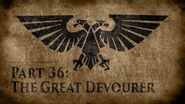
Necron bodies are composed entirely of necrodermis.
Necrodermis is the xenos material created over sixty million standard years ago by the Necrontyr species that is often described as "living metal." It was originally used by the Necrontyr to construct their massive sub-light starships that explored and settled the Milky Way Galaxy millions of standard years ago.
It was later adapted to create the robotic bodies possessed by the C'tan and inhabited by the Necrontyr after they agreed to have their consciousnesses transferred from their short-lived organic forms. This process transformed the Necrontyr into the undying Necrons.
Necrodermis is a material of unknown origin and chemical or molecular structure that possesses the extraordinary ability to regenerate almost all damage instantaneously, "flowing" back together as if it were a liquid while closing bullet holes, mending gashes and tears, or even reattaching severed pieces with little delay.
The material is also adaptive in some unknown fashion and can learn to repair itself given enough time from nearly any form of damage, even a blast powerful enough to reduce it to its constituent molecules or atoms. In addition to the bodies of the C'tan and the Necrons themselves, all Necron vehicles and starships are made from necrodermis.
C'tan[]
The Necron Star Gods, the C'tan, are entities of pure energy that can only interact with the physical universe through the possession of robotic bodies crafted for them by the ancient Necrontyr from necrodermis. The shape of their necrodermis body can be modified at will by its possessing C'tan, or C'tan Shard as they currently exist, and so each Star God looks very different from its fellows.
C'tan Shards can also shape powerful slashing or cutting blades from their bodies at will or shapeshift in such a way that they can appear to be a member of almost any species. If a C'tan Shard's necrodermis body is breached, the C'tan essence is released with a powerful explosion of energy that can damage nearby individuals or structures.
But the C'tan Shard is not slain, but instead now free to act according to its own whims without having to obey its Necron masters. Most commonly its first act would be to take revenge on its previous captors.
C'tan Phase Weapons[]
The C'tan Phase Weapons used by the Imperium's Callidus Assassins are also made of necrodermis. These weapons were adapted from the remains of Necron technology discovered to lie buried dormant under Mars by the Adeptus Mechanicus many millennia ago.
Their blades can move out of phase with the space-time continuum much like the Necrons themselves do and so cannot be blocked by any defence save for another weapon crafted from necrodermis.
Asirnoth[]
It has been hypothesized by some Imperial savants after the Imperium of Man made first contact with the Necrons that Asirnoth, the strange Silver Wyrm that the primarch of the Iron Hands Legion, Ferrus Manus, battled on the volcanic world of Medusa over 10,000 Terran years ago may have been a Necron construct created from necrodermis.
When Manus' hands were coated with a silvery metal that melted from the Silver Wyrm's body, that material was absorbed into his skin and became a part of his body rather than injuring him. This would accord with the way necrodermis has been observed to act by Imperial scholars, though this remains only conjecture.
Necron Vehicle Armour[]
The war machines of the Necrons are things of impossible science and countless arcane technologies. To the young species of the galaxy, the energies and weaponry of these strange engines of destruction are more akin to magic than anything recognisable as physical engineering.
The Living Metal composite is a perfect example of this kind of advanced technology -- a substance that defies harm by literally healing itself before the eyes of its attacker. Though the means can vary between Necron dynasties and the skills of the Crypteks that serve them, this miracle is often the result of billions-strong swarms of nanoscarabs crawling under the necrodermis skin of the war machine.
Like the living cells of biological creatures they will seek out damaged areas and cluster around them, mouths the size of atoms chewing up matter and forging it back together. However, as with most of the Necrons' arcane techno-sciences, there are almost as many ways to manipulate matter as there are Crypteks.
Captive phase-gates, subatomic infusers and temporal loop shrouds can all exhibit similar effects to nanoscarab swarms. To a Necron Overlord, how these abilities work is of little concern, as long as they do.
Videos[]
Sources[]
- Codex: Necrons (3rd Edition), pp. 8, 25
- Codex: Necrons (7th Edition) (Digital Edition), pg. 49
- Index Astartes III
- Fulgrim (Novel) by Graham McNeill
- Angel Exterminatus (Novel) by Graham McNeill

